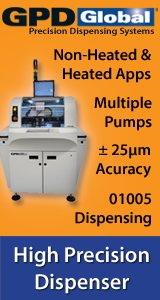Printed Circuit Board Assembly & PCB Design Forum
SMT electronics assembly manufacturing forum.
- SMTnet
- »
- Electronics Forum
- »
- Selective soldering pallets and solder balls
Selective soldering pallets and solder balls
![]() We're trying a selective soldering pallet for the first time...
- Dec 02, 2002
by
Steve Thomas
We're trying a selective soldering pallet for the first time...
- Dec 02, 2002
by
Steve Thomas
![]()
![]()
![]() Hi Steve
The people who will have the answer is the exper...
- Dec 02, 2002
by
Hi Steve
The people who will have the answer is the exper...
- Dec 02, 2002
by
![]()
![]()
![]() If you can, attach athermocouple to the locations where you ...
- Dec 02, 2002
by
RDR
If you can, attach athermocouple to the locations where you ...
- Dec 02, 2002
by
RDR
![]()
![]()
![]() Unfortunately it's nc or we'd be worrying about this on the ...
- Dec 02, 2002
by
Steve Thomas
Unfortunately it's nc or we'd be worrying about this on the ...
- Dec 02, 2002
by
Steve Thomas
![]()
![]()
![]() Steve,
I agree with the recommendation to check the tempera...
- Dec 02, 2002
by
Steve,
I agree with the recommendation to check the tempera...
- Dec 02, 2002
by
![]()
![]() Hi,
Try to check if there is water absorbed in the flux ...
- Dec 02, 2002
by
Kris
Hi,
Try to check if there is water absorbed in the flux ...
- Dec 02, 2002
by
Kris
![]()
![]()
![]() We haven't run a profile yet....probably because we're
a-f...
- Dec 03, 2002
by
Steve Thomas
We haven't run a profile yet....probably because we're
a-f...
- Dec 03, 2002
by
Steve Thomas
![]()
![]()
![]() This might be a trival mundane suggestion but try to use non...
- Dec 03, 2002
by
Kris
This might be a trival mundane suggestion but try to use non...
- Dec 03, 2002
by
Kris
![]()
![]()
![]() At the price of Durapol we'd never get the OK to have them m...
- Dec 03, 2002
by
Steve Thomas
At the price of Durapol we'd never get the OK to have them m...
- Dec 03, 2002
by
Steve Thomas
![]()
![]()
![]() I have found that preheating the solder pallets prior to use...
- Dec 04, 2002
by
James
I have found that preheating the solder pallets prior to use...
- Dec 04, 2002
by
James
![]()
![]()
![]() By the way, what type of preheaters do you have?
IR?
Conve...
- Dec 04, 2002
by
By the way, what type of preheaters do you have?
IR?
Conve...
- Dec 04, 2002
by
![]()
![]() They're IR, bottom side only. Frankly wave solder is not my...
- Dec 05, 2002
by
Steve Thomas
They're IR, bottom side only. Frankly wave solder is not my...
- Dec 05, 2002
by
Steve Thomas
![]()
![]()
![]() Have you check the flux gravity lately? If not, Check the fl...
- Dec 05, 2002
by
Have you check the flux gravity lately? If not, Check the fl...
- Dec 05, 2002
by
![]()
![]() We only have solder balling problems in the interface of the...
- Dec 06, 2002
by
Steve Thomas
We only have solder balling problems in the interface of the...
- Dec 06, 2002
by
Steve Thomas
![]()
![]()
![]() Steve,
I wave solder most if not all our boards with sele...
- Dec 10, 2002
by
Steve,
I wave solder most if not all our boards with sele...
- Dec 10, 2002
by
![]()
![]()
![]() Randy, Steve & all,
Can you guys point me in the right di...
- Dec 16, 2002
by
Randy, Steve & all,
Can you guys point me in the right di...
- Dec 16, 2002
by
![]()
![]() Jim
Consider issuing a purchase order to your assembler f...
- Dec 16, 2002
by
davef
Jim
Consider issuing a purchase order to your assembler f...
- Dec 16, 2002
by
davef
![]()
![]()
![]() Steve , I agree with all the responses you have received. ...
- Dec 16, 2002
by
David Duke
Steve , I agree with all the responses you have received. ...
- Dec 16, 2002
by
David Duke
![]()
![]()
![]() Jim,
In most cases if you can eliminate a process you wil...
- Dec 17, 2002
by
Jim,
In most cases if you can eliminate a process you wil...
- Dec 17, 2002
by
![]()
![]()
![]() There are a few emerging technologies that have been growing...
- Dec 17, 2002
by
robf
There are a few emerging technologies that have been growing...
- Dec 17, 2002
by
robf
![]()
- SMTnet
- »
- Electronics Forum
- »
- Selective soldering pallets and solder balls









